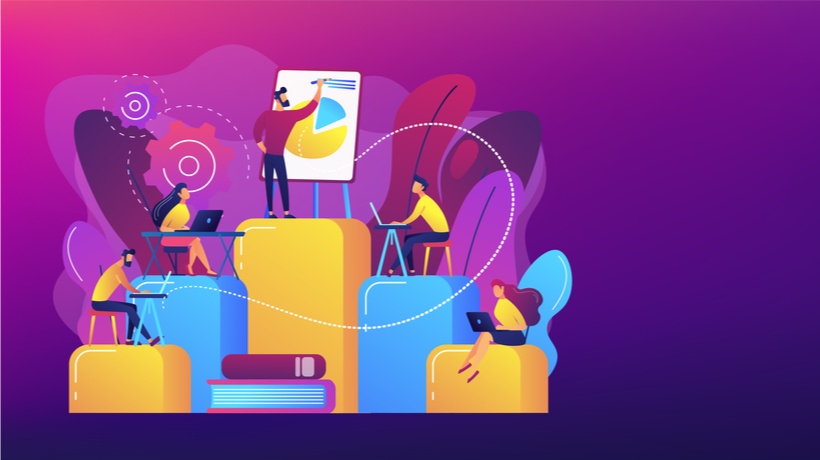Learning's Role During Uncertain Circumstances
Have you recently noticed something, and it's not for the better? Did you notice a decline in the overall quality of customer interaction with those expected to serve you? If you did, then good! I'm not going crazy...well, maybe a little, but that's a conversation for my therapist. This is not just a coincidence; there's been a significant decline in customer support since the pandemic. The question is whether those responsible for employee Learning and Development (L&D) should be held to account? Or are practitioners justified in claiming, "hey, this isn't our fault?"
Look, I get it. Times are tough for pretty much everyone. Inflation is rapidly increasing (and not just in the USA) and, unfortunately, COVID-19 continues to be an economic nuisance around the world. But the one thing persevering through all of this is what is known as the Great Resignation or the Big Quit. Even though many factors are causing real havoc for companies, the decline in customer service of any kind is a result of the Big Quit. But the Big Quit is also about managing and skilling up current and new employees to support existing needs. More on that later.
Now, if you still don't know what the Great Resignation is, well, you may be the only one. In simple terms, it's a unique economic circumstance resulting from two years of the pandemic's remote and hybrid working arrangements that resulted in people rethinking the work they do, how they do it, and where they do it. You may say, but the frontline employees didn't have the option to work remotely! True, however, due to several extended economic shutdowns they were most adversely impacted and often unexpectedly lost essential income during lockdowns and extended slow periods. Naturally, they sought out new and more secure jobs and roles. They had to. As a result, companies scrambled to fill significant shortages in key frontline positions. But they faced a vicious cycle, losing their existing employees who were seeking other sources of income from more secure and valued roles (the Big Quit), and then having to rapidly hire new, untrained staff.
Granted, never in modern employment history has there been such a large cohort of employees across all sectors rethinking their life priorities and seeking meaningful and financially rewarding work. While all of this is happening, companies are increasingly challenged to maintain staffing levels and, as a a result, maintain the quality of products and service that we, as consumers, expect to receive. This isn't happening, at least not well or to consumer expectations anyway.
Staff shortages and the problem of how to allocate staff are causing significant frustration among the general public and consumers; simply, this is what you're experiencing in poor interactions with companies. While nothing can be done about the Big Quit, the question to ask is, who should shoulder responsibility for this poor service and support? Internally, everyone must shoulder some responsibility, but some don't deserve any blame, like the employees, especially those seeking a better life and better paying and more secure income. Think about it: if you worked in an unpredictable, unwelcoming, or even hostile work environment, you'd be sprucing up your resume as well.
Does the blame rest on the company? You'd think so and chances are everyone is seeking a scapegoat. But for many internal functions, some factors are out of their control. Now, this isn't meant to shirk their responsibility to help fix the issues, but rather to appreciate how they must address this concern. While it's up to a company's leadership to ensure the operational processes runs smoothly, it's also the role and responsibility of their internal supporting functions to alleviate the stress. Yes, the spotlight is on you, human resources (HR) and Learning and Development.
You see, during turbulent times like we're currently living, company leaders expect their enabling functions to step up and answer the need at hand. When primary operational activities are down, especially during economic downturns or uncertainty, the supporting functions are expected to step up. The two supporting functions missing in action here are human resources and Learning and Development. Naturally, as they deal with people! The other supporting functions (e.g., marketing, finance, IT) don't (and these functions have their hands full with other issues at the moment). Both HR and L&D are front and center to a company's smooth operations.
Why Learning And Development Must Step Up?
Both these essential enabling functions, human resources and Learning and Development, are not living up to expectations. For HR, many external economic factors are impacting their ability to settle the high turnover issue and further exacerbating employee hiring and retention. This isn't meant to excuse them from their responsibility, but they can only work with what they can control. For L&D, however, things are somewhat different. You see, remote work or not, pandemic or not, customer service, or any essential/core skill for that matter, is something that must be continually developed and well-supported, not just for the training instance but for the duration of employee tenure.
Customer service is more than smiling and being polite. It's about problem-solving and critical thinking skills ensuring customer satisfaction accompanied by specific company processes and policies. I'm not going to get into specifics since every company will have their own approach addressing customer issues. But the point is for employees to possess and apply these skills, and not have them haphazardly apply what they are feeling at the moment of interaction.
How Can Learning and Development Adapt To Economic Uncertainty?
Let's agree to accept one collective truism, that economic uncertainty is everyone's new reality. If the pandemic has taught us one thing, no one will ever say, "It can never happen!" again. The reality is that things will happen, even things that seem impossible or implausible (e.g., the pandemic, the 2008 financial crash, major environmental issues, etc.). This economic flux is out of our direct control but will ultimately impact each person. L&D, however, is in a unique position to develop preemptive measures that won't necessarily eliminate the risks, but can mitigate and minimize their impact on the organization. How do you do this? Well, let's find out, shall we?
You need to first develop a practical learning strategy. This is where the wheels fall off for many practitioners. Many will claim, "Yes, we have a strategy, we have a bunch of courses in development." Or they'll focus on what they believe employees must learn, rather than what company stakeholders expect employees to do. Like I keep reiterating, it's never about the "learning", it's about the "doing."
A proactive learning strategy must align with the company mission, and subsequently, help to address its operational performance expectations. I've written about this repeatedly and even published a book on it, The Trainer's Balanced Scorecard, so please access these resources.
If you have a learning strategy, then its time to revisit it. Too often practitioners will develop one, feel proud for doing so, and then place it on a shelf without another glance. Time to dust it off and, most probably, have to redo it. If you want to ensure that your stakeholders see value in what you have to offer, then I strongly suggest you become proactive, interview those requiring your services, conduct needs assessments, and determine what the company needs for the future, and not just for now.
Next, develop a learning contingency strategy. OK, you're now probably saying, "Yes, but we just developed a learning strategy like you told us to do! Why this?" The answer is, what if things don't go according to plan? Or, as I like to say, expect the unexpected. Your stakeholders refer to this as risk management. And while they'll have a primary strategic plan in place, they will have contingencies in place as well. These are what they call "what if" scenarios. You need to ask the same question, by developing learning contingencies based on their contingency plans.
Then, you need to prepare to be tactical and guerilla. Yes, it's nice to properly plan, design, develop, test, and fully deploy learning initiatives, but what happens when you're needed now? You can throw all of that right out of the window! Ask yourself, if your stakeholders came to you with an immediate need, can you respond? Can you pivot to meet their needs and address their expectations?
This is not a good time to lie to yourself and pretend that you can. You need to be honest. If you're not sure, conduct a drill simulation with a key stakeholder. Go to them and ask if they could oblige in unexpectedly coming to you with an immediate and unforeseen employee development emergency. Then see whether you're capable of responding in a timely manner. Assess your weaknesses and why you don't have the resources you need, and consider where to reallocate resources that you do have available. You'll want to make this an iterative occurrence.
Finally, you must leverage your learning technology. The one thing that every practitioner yearns for is more learning tech. But the adage "be careful what you wish for" comes to mind. For your stakeholders, the "e" in eLearning (this encompasses any learning tech) implies "efficiencies" and/or "effectiveness", and so should it imply to you. Your technology can equip you to address many of the previous points. Any eLearning technology should help you to design real-time learning that employees can access at any time and from anywhere. This is tactical and practical and would impress your stakeholders and operational partners.
Consider leveraging the data collected and compiled through your Learning Management System and assessment/testing technologies. Analysis (or analytics) of this data, if you're collecting valued internal user information, can deliver you insight into employee and organizational needs. Trust me on this, I've contributed to a multinational becoming number one in worldwide customer support based on this analysis alone.
It's Now Up To You
This article is like having to take a spoonful of bad tasting cough medicine, but it's not meant to be accusatory. Rather, it's meant to shine a spotlight on the relevance and importance of the role that Learning and Development play within the context of business operations and performance. Your leaders want your efforts to be successful...so, please prove them right!
Please share your thoughts and feedback with us. We would enjoy hearing about your efforts. And who knows, it may be the topic of our next eLearning Industry article. Also, please check out our LinkedIn Learning courses to learn more about developing business credibility for your learning efforts. Please share your thoughts and remember #alwaysbelearning!
Want To Build Your Facilitation Skills?
Register for this Developing Professional Training And Facilitation Skills eLearning course, designed both for recent trainers and seasoned veterans. Register today to receive promotional pricing and a free eBook! Learning is not only for your participants...as a trainer you must lead by example and be a learner yourself.









